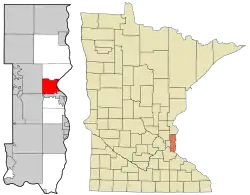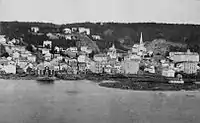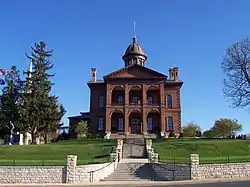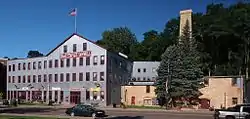Stillwater | |
|---|---|
 The waterfront of Stillwater on the St. Croix River | |
|
Seal | |
| Nickname: The Birthplace of Minnesota | |
 Location of the city of Stillwater within Washington County, Minnesota | |
 Stillwater | |
| Coordinates: 45°3′N 92°49′W / 45.050°N 92.817°W | |
| Country | United States |
| State | Minnesota |
| County | Washington |
| First settled | October 26, 1843 |
| Government | |
| • Mayor | Ted Kozlowski |
| Area | |
| • Total | 9.07 sq mi (23.50 km2) |
| • Land | 8.05 sq mi (20.84 km2) |
| • Water | 1.03 sq mi (2.66 km2) |
| Elevation | 866 ft (264 m) |
| Population (2020) | |
| • Total | 19,394 |
| • Density | 2,410.39/sq mi (930.66/km2) |
| Time zone | UTC−6 (CST) |
| • Summer (DST) | UTC−5 (CDT) |
| ZIP Codes | 55082, 55083 |
| Area code | 651 |
| FIPS code | 27-62824 |
| GNIS feature ID | 2395969[2] |
| Website | www.ci.stillwater.mn.us |
Stillwater is a city in the U.S. state of Minnesota and the county seat of Washington County. It is in the Minneapolis–Saint Paul metropolitan area, on the west bank of the St. Croix River, across from Houlton, Wisconsin. Stillwater's population was 19,394 at the 2020 census.[3][4] Stillwater is often called "the birthplace of Minnesota"[5] due to its role in the establishment of the state.
Geography
According to the United States Census Bureau, the city has an area of 7.98 square miles (20.67 km2); 6.96 square miles (18.03 km2) is land and 1.02 square miles (2.64 km2) is water.[6] State Highways 36, 95, and 96 are three of the community's main routes.
Climate
Stillwater receives an average annual snowfall of 42 inches (1,100 mm). Average annual rainfall is 24 in (610 mm). Each year has an average of 14 days above 90 °F (32 °C).
Name
The name "Stillwater" was proposed in 1843 by John McKusick, who built the settlement's first sawmill. McKusick was later a state senator.[7] The name derives from the St. Croix River's calmness near the town center.[8] It is also believed that McKusick had fond memories of Stillwater, Maine, where he had migrated from.[7]
Long before European Americans arrived, the area was occupied by various indigenous peoples for thousands of years. The Dakota people called it Hoġan Wanḳe Kin,[9] a term that encompassed not only the St. Croix River but also Lake St. Croix and a large sandbar across from present-day Afton. The name, meaning "the place where the fish lies", derived from a legend in which a man was transformed into a giant fish (a catfish or a pike, depending on the version) and then into a sandbar.[10] In English, Hoġan Wanḳe Kin has been spelled variously as Hogan-wahnkay-kin, Hogan-wauke-kin and Hogan-wan-kee.[11]
The Ojibwe name for the place was Giigoonzh-agomod, with the slightly different meaning of "where the fish floats".[12] The Ojibwe origin legend is very similar, also involving a man transformed into a giant fish and found floating in the lake. He was ultimately transformed into "a piece of land crossing the lake there" (i.e., the sandbar). In English renderings, Giigo onh-zhagomod has been spelled as Kee-go-shagewa-minnie[13] and Kegan-Shaw-Ga-Nut.
History

In the 1830s, European Americans were pressing west into this territory. The U.S. government tried to arrange for their settlement in Native American lands, and on July 29 and September 29, 1837, it signed treaties with the local Ojibwe and Dakota nations to allow such settlement in the St. Croix Valley.
The settlement was founded on October 26, 1843, when four partners formed the Stillwater Lumber Company.[14] Settlers were drawn by the area's abundant lumber and river traffic resulting from the industry. This was one of Minnesota's oldest towns, preceding Minneapolis by several years. Stillwater was officially incorporated as a city on March 4, 1854 (the same day as St. Paul).
Stillwater is often called the birthplace of Minnesota.[5] In 1848, a territorial convention that began the process of establishing Minnesota as a state was held in Stillwater, at the corner of Myrtle and Main streets. Originally part of the Wisconsin Territory, Minnesota officially became a separate territory in 1849 and, after population increases, a state in 1858.
As more evidence of Stillwater's importance at the time, the territorial convention selected three leading Minnesota cities as locations for three important public institutions: Saint Paul was designated as the capital; the University of Minnesota was established at Minneapolis; and Stillwater became the site of the territory's first prison. The Minnesota Territorial Prison (later Minnesota State Prison) was opened in 1853. The prison held Cole, Jim, and Bob Younger, three of the Younger brothers of the James–Younger Gang.
Lumbering was the predominant industry in the St. Croix River Valley in the second half of the 19th century. For many years, lumbermen sent large rafts of logs down the St. Croix. They were collected at the St. Croix Boom Site two miles upstream of Stillwater, and processed in Stillwater's many sawmills. Steamboats were used most widely on the river from 1860 to 1890. A few still operate as entertainment venues today.
David Swain operated a shipyard and engine works in Stillwater. Excursion steamboats, such as the Verne Swain and the Capitol, began to operate in the early 20th century, taking passengers to other cities along the river.[15]
During the American Civil War, Stillwater sent men of the 1st Minnesota Volunteer Infantry Company B, 5th Minnesota Infantry Regiment Company K, and the 8th Minnesota Volunteer Infantry Regiment Company C, among others, to fight for the Union.[16][17][18]
On October 18, 1921, Charles Strite invented the automatic pop-up bread toaster in Stillwater. By 1926, the Toastmaster Company began to market the first household toaster using a redesigned version of Strite's invention.[19] In 1923, Nelson's Ice Cream parlor was established.[20]
In 1931, construction of the Stillwater lift bridge over the St. Croix River was completed at a final cost of $460,174, which was split equally between Minnesota and Wisconsin.[21] The lift bridge is one of the city's most iconic and visible local monuments. It was part of Minnesota State Highway 36 until 2017, when it closed to vehicle traffic. In 2020 it became part of a five-mile trail loop running through Stillwater and Houlton, Wisconsin.[22]
In 1996 the city of Stillwater entered into an agreement with Stillwater Township to annex land. In 2015 the Stillwater city council approved the annexing the last of the land covered by the agreement. The city's western border is now Manning Avenue (County Road 15). The northern border is now mostly, but not entirely, Minnesota Highway 96.[23]
 Stillwater c. 1860s
Stillwater c. 1860s
 Across the street from the Courthouse, the Veterans' Memorial for local veterans
Across the street from the Courthouse, the Veterans' Memorial for local veterans Lift Bridge
Lift Bridge Isaac Staples Sawmill
Isaac Staples Sawmill
Demographics
| Census | Pop. | Note | %± |
|---|---|---|---|
| 1860 | 2,380 | — | |
| 1870 | 4,124 | 73.3% | |
| 1880 | 9,055 | 119.6% | |
| 1890 | 11,260 | 24.4% | |
| 1900 | 12,318 | 9.4% | |
| 1910 | 10,198 | −17.2% | |
| 1920 | 7,735 | −24.2% | |
| 1930 | 7,173 | −7.3% | |
| 1940 | 7,013 | −2.2% | |
| 1950 | 7,674 | 9.4% | |
| 1960 | 8,310 | 8.3% | |
| 1970 | 10,191 | 22.6% | |
| 1980 | 12,290 | 20.6% | |
| 1990 | 13,882 | 13.0% | |
| 2000 | 15,143 | 9.1% | |
| 2010 | 18,225 | 20.4% | |
| 2020 | 19,394 | 6.4% | |
| U.S. Decennial Census[24] [25] | |||
Historic census data
1870
1880
1890
- White: 11,209 (99.55%)
- Colored: 18 (0.16%)
- Civilized Indian: 1 (0.01%)
- Total: 11,260
1910
- White: 10,131 (99.4%)
- Born in U.S. to two U.S.-born parents: 2,447 (23.99%)
- Born in U.S. to one or two foreign-born parents: 4,910 (48.15%)
- Born outside U.S. 2,774 (27.2%)
- African American: 56 (0.49%)
- Chinese, Japanese, or Indian: 5 (0.05%)
- Total: 10,199[25]
1920
- White: 10,137 (99.95%)
- Born in U.S. to two U.S.-born parents: 2,384 (30.82%)
- Born in U.S. to one or two foreign-born parents: 3,683 (47.61%)
- Born outside U.S. 1,664 (21.51%)
- African American: 4 (0.05%)
- Total: 7,735
1940
- White: 7,012 (99.99%)
- Other: 1 (0.01%)
1950
- White: 99.9%
- Other: 0.1%
1960
- White: 99.9%
- Other: 0.1%
1970
- White: 10,159 (99.73%)
- African American: 1 (0.01%)
- Indian: 12 (0.12%)
- Asian: 9 (0.09%)
- Japanese: 3 (0.03%)
- Filipino: 6 (0.06%)
- Other: 6 (0.06%)
2000 census
As of the census of 2000, there were 15,143 people, 5,797 households, and 4,115 families living in the city. The population density was 2,340.0 inhabitants per square mile (903.5/km2). There were 5,926 housing units at an average density of 915.7 per square mile (353.6/km2). The racial makeup of the city was 94.0% White, 0.9% African American, 0.4% Native American, 1.1% Asian, 0.02% Pacific Islander, 0.1% from other races, and 1.6% from two or more races. Hispanic or Latino of any race were 1.9% of the population.
There were 5,797 households, out of which 36.8% had children under the age of 18 living with them, 57.2% were married couples living together, 10.8% had a female householder with no husband present, and 29.0% were non-families. 24.3% of all households were made up of individuals, and 9.0% had someone living alone who was 65 years of age or older. The average household size was 2.55 and the average family size was 3.07.
In the city, the population was spread out, with 27.7% under the age of 18, 6.3% from 18 to 24, 28.8% from 25 to 44, 25.4% from 45 to 64, and 11.8% who were 65 years of age or older. The median age was 38 years. For every 100 females, there were 92.9 males. For every 100 females age 18 and over, there were 86.7 males.
The median income for a household in the city was $57,154, and the median income for a family was $72,188. Males had a median income of $49,158 versus $33,680 for females. The per capita income for the city was $27,163. About 3.0% of families and 4.3% of the population were below the poverty line, including 5.6% of those under age 18 and 5.3% of those age 65 or over.
2010 census
As of the census[26] of 2010, there were 18,225 people, 7,075 households, and 4,885 families living in the city. The population density was 2,618.5 inhabitants per square mile (1,011.0/km2). There were 7,576 housing units at an average density of 1,088.5 per square mile (420.3/km2). The racial makeup of the city was 95.1% White, 1.0% African American, 0.4% Native American, 1.1% Asian, 0.6% from other races, and 1.8% from two or more races. Hispanic or Latino of any race were 1.9% of the population.
There were 7,075 households, of which 35.6% had children under the age of 18 living with them, 54.3% were married couples living together, 11.0% had a female householder with no husband present, 3.8% had a male householder with no wife present, and 31.0% were non-families. 25.5% of all households were made up of individuals, and 8.7% had someone living alone who was 65 years of age or older. The average household size was 2.51 and the average family size was 3.03.
The median age in the city was 40 years. 26.5% of residents were under the age of 18; 6.7% were between the ages of 18 and 24; 25.3% were from 25 to 44; 29% were from 45 to 64; and 12.8% were 65 years of age or older. The gender makeup of the city was 48.5% male and 51.5% female.
2020 census
As of the 2020 census, there were 19,394 people living in the city.
The racial makeup of the city was 89.9% White alone (95.4% White alone or in combination), 1.7% Black or African American, 0.3% American Indian and Alaska Native, 1.5% Asian, 0.05% Pacific Islander, 0.9% from other races, and 5.6% from two or more races. Hispanics of any race were 3.2% of the population.
According to the American Community Survey estimates for 2016-2020, the median income for a household in the city was $91,947, and the median income for a family was $109,151. Male full-time workers had a median income of $73,986 versus $67,005 for female workers. The per capita income for the city was $48,553. About 3.3% of families and 5.2% of the population were below the poverty line, including 4.6% of those under age 18 and 5.9% of those age 65 or over.[27] Of the population age 25 and over, 96.4% were high school graduates or higher and 46.6% had a bachelor's degree or higher.[28]
Education
Stillwater has a mix of public district, public charter, and private schools at the primary and secondary levels. The city is served by the Stillwater Area Public Schools system and the nearest high school is Stillwater Area High School in Oak Park Heights, Minnesota.
Notable people
- Thomas J. Abercrombie, photographer, first journalist to reach South Pole, Born in Stillwater
- Ed Ackerson, musician (Polara, The 27 Various) and record producer (The Jayhawks, The Replacements, Motion City Soundtrack), born and attended high school in Stillwater
- Brian Arnfelt, NFL defensive end, attended high school in Stillwater
- Michele Bachmann, U.S. Representative, lived in Stillwater
- Ben Blankenship, member of Team USA Track and Field who set the world record in the distance medley
- Robert Brown, Minnesota state senator and educator, born in Stillwater
- Noah Cates, professional ice hockey player for the Philadelphia Flyers, born in Stillwater
- James B. Clark, director and Oscar-nominated film editor, born in Stillwater
- Jessie Diggins, Olympic gold medalist in cross-country skiing, attended high school in Stillwater
- Nate Dwyer, NFL linebacker, born in Stillwater
- Chris Engler, NBA player, born in Stillwater
- Otto Folin, biochemist, educated in Stillwater
- Sam Gorski and Niko Pueringer, creators of Corridor Digital
- Sean Graham, retired professional track athlete and current head track and cross country coach at American University
- Nicole Hause, skateboarder for REAL Skateboards and Nike SB, originally from Stillwater
- Patrick Hicks, novelist, poet, and essayist, grew up in Stillwater
- Phil Housley, Hockey Hall of Fame player and NHL coach, coached in Stillwater
- Sherri Jarvis, murder victim
- Todd Kalis, NFL guard, born in Stillwater
- Jessica Lange, actress, resided in Stillwater
- Frankie Lee, musician, born in Stillwater
- Chris Maddock, stand-up comedian[29]
- Jonah Marais, member of boy band Why Don't We
- Denis McDonough, 11th Secretary of Veterans Affairs and White House Chief of Staff for President Obama, born in Stillwater
- Harriet McPherson, Minnesota state legislator, farmer, and educator
- Bob Nelson, NFL linebacker, born in Stillwater
- Socrates Nelson, Minnesota state senator, resided in Stillwater
- Karl G. Neumeier, Minnesota state senator and lawyer, born in Stillwater
- Glen Perkins, pitcher for Minnesota Twins, born in Stillwater
- Sam Shepard, playwright and actor, resided in Stillwater
- Zach Sobiech, musical artist who wrote the #1 hit “Clouds” after being diagnosed with osteosarcoma; inspiration for the Disney film Clouds
- Rich Sommer, actor, raised in Stillwater
- LaVyrle Spencer, a New York Times bestselling author, lived in Stillwater
- Alpheus Beede Stickney, a famous railroad builder, lived in Stillwater, born in Maine
- C. Gardner Sullivan, screenwriter and producer, born in Stillwater
- John B. Taft, farmer and Minnesota state legislator, resided in Stillwater
- Butch Thompson, jazz pianist and clarinetist, went to high school in Stillwater[30]
- Thomas Vanek, ice hockey forward for the Minnesota Wild, resides in Stillwater
See also
References
- ↑ "2020 U.S. Gazetteer Files". United States Census Bureau. Retrieved July 24, 2022.
- 1 2 U.S. Geological Survey Geographic Names Information System: Stillwater, Minnesota
- ↑ "2020 Decennial Census: Stillwater city, Minnesota". data.census.gov. U.S. Census Bureau. Retrieved March 24, 2023.
- ↑ "Find a County". National Association of Counties. Archived from the original on May 31, 2011. Retrieved June 7, 2011.
- 1 2 "The birth of Minnesota" (PDF). mnhs.org. 1997. Archived (PDF) from the original on February 22, 2012. Retrieved January 26, 2017.
- ↑ "US Gazetteer files 2010". United States Census Bureau. Archived from the original on January 12, 2012. Retrieved November 13, 2012.
- 1 2 Upham, Warren (1920). Minnesota Geographic Names: Their Origin and Historic Significance. Minnesota Historical Society. p. 571.
- ↑ Chicago and North Western Railway Company (1908). A History of the Origin of the Place Names Connected with the Chicago & North Western and Chicago, St. Paul, Minneapolis & Omaha Railways. p. 165.
- ↑ "Dakota spoken here: Mni Sota's Dakota Indian heritage topic of Minnesota Book Award winner". www.tcdailyplanet.net/. Retrieved August 19, 2022.
- ↑ "Afton--Washington County Historical Society". www.wchsmn.org/afton/. Retrieved August 19, 2022.
- ↑ Neill, Rev. Edward D (1881). History of Washington County and the St. Croix Valley, Including the Explorers and Pioneers of Minnesota. North Star Publishing Company. p. .
- ↑ "Nookomis Gaa-Inaajimotawi: What My Grandmother Told Me," in Oshkaabewis Native Journal" (PDF). www.bemidjistate.edu. Archived (PDF) from the original on July 23, 2019. Retrieved August 19, 2022.
- ↑ "How Stillwater Came to Be" (PDF). www.mnhs.org/. Archived (PDF) from the original on October 19, 2012. Retrieved August 19, 2022.
- ↑ Folsom, William H.C. (1888). Fifty Years in the Northwest. Pioneer Press Company. pp. 38–39.
- ↑ Brent T. Peterson. Stillwater. Charleston, SC: Arcadia Publishing. p. 80.
- ↑ From the Journal of Sgt. Sam Bloomer 1st Minnesota Volunteer Infantry Part I'
- ↑ Historians seek Stillwater Civil War unit's flag
- ↑ Easton, A.B. 1909. History of the Saint Croix Valley, vol. 1, pp. 40-58. Chicago: H.C. Cooper, Jr. & Co. This source contains a detailed list.
- ↑ "Patent for Bread-Toaster Issued October 18, 1921". www.uspto.gov. Archived from the original on February 1, 2015. Retrieved January 26, 2017.
- ↑ Miron, Michelle (August 16, 2012). "Nelson's continuing 89-year tradition of local treats". Presspubs.com. Retrieved October 23, 2013.
- ↑ "Stillwater Lift Bridge". dot.state.mn.us. 2020. Retrieved August 25, 2020.
- ↑ "St. Croix Crossing". dot.state.mn.us. 2020. Retrieved August 25, 2020.
- ↑ "Stillwater approves long anticipated annexation". Retrieved December 13, 2017.
- ↑ United States Census Bureau. "Census of Population and Housing". Retrieved June 9, 2014.
- 1 2 United States census (1910). "Minnesota" (PDF). Retrieved October 17, 2023. 1860—1910 data.
- ↑ "U.S. Census website". United States Census Bureau. Retrieved November 13, 2012.
- ↑ "Selected Economic Characteristics, 2020 American Community Survey: Stillwater city, Minnesota". data.census.gov. U.S. Census Bureau. Retrieved March 24, 2023.
- ↑ "Selected Social Characteristics, 2020 American Community Survey: Stillwater city, Minnesota". data.census.gov. U.S. Census Bureau. Retrieved March 24, 2023.
- ↑ Kink, Julie (May 30, 2014). "Funny man comes from a long line of 'censored performers'". St. Croix Valley Area News. Stillwater, Minnesota. Retrieved October 5, 2020.
- ↑ Fredericksen, Jane (May 7, 2009). "Marine native Butch Thompson celebrates jazz roots". The Lowdown. Retrieved March 16, 2014.
